Seek Nutrition Advice for Feeding Foals

Weaning can be wrought with confusion for both the foal and owner. Too much energy, too little energy, imbalanced micronutrients, or just the wrong diet altogether potentially culminates in major health problems, such as osteochondritis dissecans (OCD). Should you creep feed and wean gradually, or take the cold-turkey approach and separate mare and foal abruptly? Should you choose a high- or low-forage diet for the weanling?
To help answer these questions, veterinarians and nutritionists studied 24 Quarter Horse and Arabian foals and performed digestion trials at 5 and 8 months of age*. Those foals were offered one of three diets with various concentrate-to-roughage ratios:
- 70:30 (dubbed the high-concentrate diet or High Con);
- 50:50 (Equal); and
- 30:70 (Low Con).
The concentrate was a commercial product, and hay was a 35-65% alfalfa-grass hay mix.
After a 10-day adaptation period, total feces was collected for four days to measure the digestibility of each diet. What did we learn from this study?
- All foals gained weight equally regardless of diet, and dietary intake was similar among all three groups;
- Foals consuming the Low Con diet had significantly greater fecal output than High Con (not surprising as their roughage intake was higher); and
- Foals offered the High Con diet had the highest crude protein (CP) digestibility.
“Overall, these findings suggest that weanlings seem to digest protein more thoroughly when fed high-concentrate diets and may digest fiber more efficiently when fed diets higher in fiber,” explained Kathleen Crandell, Ph.D., a Kentucky Equine Research nutritionist. “This study only looked at digestibility of the diets. It’s important to recognize that the researchers did not report any effects of diet on health or soundness with long-term feeding of those diets.”
The researchers also offered the following caveat to consider: feeding high-fiber diets to young horses must be done cautiously because some forage-based diets may not contain adequate or balanced micronutrients, especially if forage analysis was not performed.
“On the flipside, high-concentrate diets or those with too many calories can result in increased growth rates, which may be associated with greater musculoskeletal abnormalities such as OCD,” Crandell reminded.
The researchers mentioned that a variety of factors play into the feeding of a healthy weanling, underscoring the importance of “evaluating all aspects of the management of young horses.”
“Any owner or manager with concerns about the dietary management of their foals is urged to seek the assistance of a nutritionist. Kentucky Equine Research offers such a service, and works with partner feed companies to maximize the nutrition of all horses, regardless of age, sex, breed, and use,” Crandell advised.
*Turcott-White, S.K., B.D. Nielsen, C.I. Robison, et al. Influence of various concentrate-to-roughage ratios on dietary intake and nutrient digestibilities of weanling horses. Journal of Animal Physiology and Animal Nutrition (Berl). In press.








